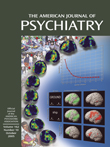To the Editor: Older antipsychotics (chlorpromazine and haloperidol) elicit extrapyramidal signs and prolactinemia, compatible with the idea that these typical antipsychotics bind more tightly than dopamine itself to the dopamine D
2 receptor, with dissociation constants that are lower than those for dopamine
(1). The newer atypical antipsychotics, such as quetiapine, clozapine, and remoxipride, bind more loosely than dopamine to the D
2 receptor, with dissociation constants that are higher than those for dopamine, thus minimizing extrapyramidal signs.
These data agree with the rates of antipsychotic dissociation from human cloned D
2 (1–
3). For instance, haloperidol, chlorpromazine, and raclopride dissociate slowly over 30 minutes, whereas quetiapine, clozapine, remoxipride, and amisulpride dissociate rapidly, in less than 60 seconds
(1). These data match brain imaging findings that show haloperidol remaining constantly bound to D
2 in humans undergoing two positron emission tomography scans 24 hours apart, whereas the occupation of D
2 by clozapine or quetiapine has mostly disappeared after 24 hours (reviewed in reference
1). Atypical antipsychotics, therefore, are helpful to patients by transiently occupying D
2 and then rapidly dissociating to allow dopamine neurotransmission. This keeps prolactin levels normal, spares cognition, and obviates extrapyramidal signs.
This letter provides data on the off-rates of additional newer atypical antipsychotics, using methods similar to those reported for the human cloned D
2Long receptor in tissue culture cells
(1,
2) and drug concentrations found in the spinal fluid of patients
(4). The times for 50% dissociation from D
2 were the following: 42 seconds for 4 nM S-(-)-amisulpride, 66 seconds for 40 nM amoxapine, 52 seconds for 10 nM aripiprazole, 30 minutes for 1.5 nM chlorpromazine, 15 seconds for 200 nM clozapine, 38 seconds for 1 nM domperidone, 38 minutes for 2 nM haloperidol, 16 minutes for 20 nM loxapine, 17 minutes for 5 nM olanzapine, 24 seconds for 140 nM perlapine, 16 seconds for 200 nM quetiapine, 23 minutes for 4 nM raclopride, 13 seconds for 5 nM remoxipride, 27 minutes for 2 nM risperidone, and 60 seconds for 2 nM paliperidone (9-hydroxy-risperidone).
The data for the rapidly dissociating antipsychotics (amoxapine, aripiprazole, clozapine, perlapine, quetiapine, remoxipride, and paliperidone) are compatible with their low extrapyramidal signs. The extent of risperidone-associated extrapyramidal signs may depend on the proportions of risperidone and its metabolite, paliperidone, in the patient. Olanzapine has a slow off-rate from D
2, compatible with its dose-dependent incidence of extrapyramidal signs; however, the potent anticholinergic action of olanzapine (its dissociation constant of 2.1 nM matches that of benztropine at the muscarinic receptor) provides an effective anti-extrapyramidal-sign mechanism
(1).

